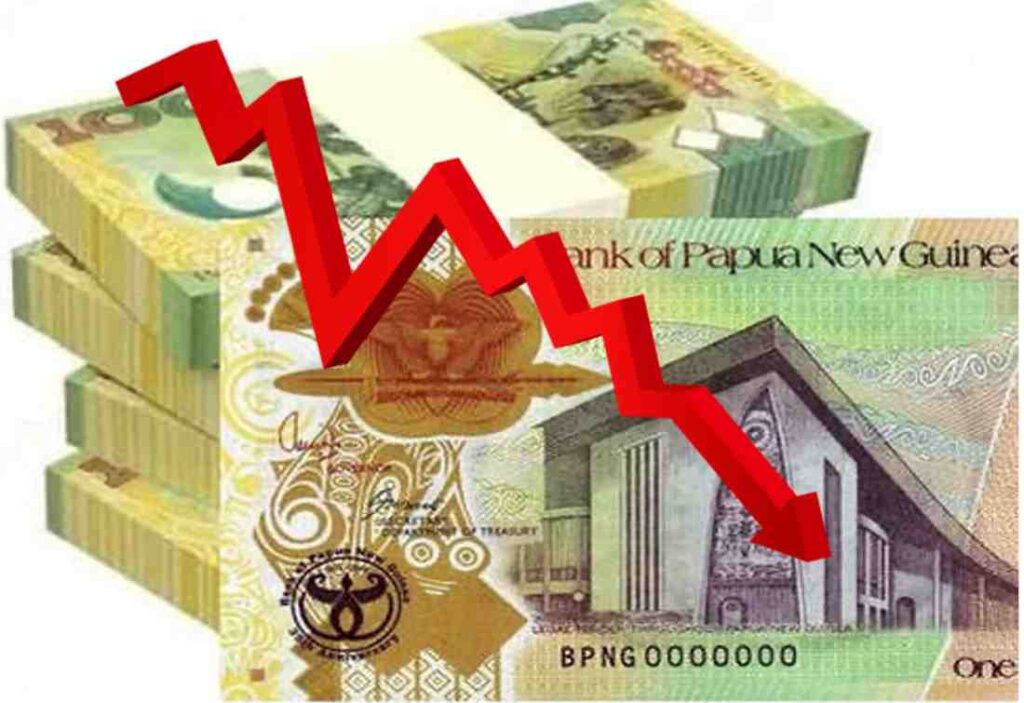The Kina’s Decline

Understanding the Challenge and Exploring SolutionsPapua New Guinea’s national currency, the Kina, is facing a decline that is expected to persist in the upcoming months. According to the latest report from BSP’s Pacific Quarterly Economic & Market Pulse for the June quarter of 2024, the Kina is projected to decrease by 0.7% per month, resulting in an 8.5% annual decline. This situation is particularly concerning against the Australian Dollar, mainly due to improving interest rate differentials with the US Dollar.
Understanding the Current Situation
The report highlights that the foreign exchange (FX) inflows in the country, which were significantly high last quarter, are anticipated to decrease. This reduction is partly because some fuel imports will now be settled in foreign currency. The Bank of South Pacific (BSP) has noted that the intervention by the Bank of Papua New Guinea (BPNG) is crucial in addressing the ongoing imbalance between FX inflows and outflows.
During the second quarter of 2024, the foreign exchange market turnover increased by 24.7% from the first quarter, reaching K14.2 billion. This increase was primarily driven by an 18.3% rise in inflows from exporters, state-owned enterprises, and program support packages, which amounted to K5.4 billion.
Moreover, the Bank of Papua New Guinea’s foreign exchange interventions grew by 50.9% to K1.69 billion. This represented 23.8% of total FX inflows in Q2, up from 21.7% in Q1. This intervention played a pivotal role in reducing BSP’s outstanding FX orders from K863 million in mid-May to K342 million by the end of the quarter. As a result, the execution times for FX orders improved, shortening to between 2 and 4 weeks, although fluctuations between 2 and 8 weeks are expected in Q3 2024.
The Kina’s Struggle Against Global Currencies
The depreciation of the Kina against major currencies is concerning. Under the “crawling peg” system, the Kina has fallen to 0.2600 against the US Dollar. Additionally, it has declined by 3.7% to 0.3912 against the Australian Dollar due to improved AUD/USD interest rate differentials.
Rising Australian inflation has increased expectations for a rate hike in September, while the market anticipates the first US rate cut in Q4 2024. This scenario is supported by stable inflation in a resilient US economy, adding further pressure on the Kina.
Solutions from Other Countries
Other countries facing similar challenges have implemented various strategies to stabilize their currencies. Some of these solutions include:
- Interest Rate Adjustments: By altering interest rates, countries can influence foreign investments and control inflation. For instance, countries like Brazil have used interest rate hikes to attract foreign capital and stabilize their currency.
- Foreign Exchange Reserves: Countries like China and India have built substantial foreign exchange reserves, allowing them to intervene in the market when necessary to stabilize their currency.
- Trade Balance Improvements: Nations like South Korea have focused on improving their trade balance by boosting exports and reducing imports, thereby increasing foreign exchange inflows.
- Diversifying Economic Activities: Countries such as Singapore have diversified their economic activities to reduce dependence on a single sector, thereby strengthening their currency’s resilience.
How Papua New Guinea Can Combat the Decline
Papua New Guinea can adopt several strategies to address the declining value of the Kina:
- Strengthening Export Sectors: By focusing on enhancing the efficiency and competitiveness of key export sectors like agriculture, mining, and natural resources, PNG can increase foreign exchange inflows.
- Encouraging Foreign Investment: Creating a conducive environment for foreign investments through policy reforms and incentives can attract more foreign capital, thereby strengthening the Kina.
- Building Foreign Exchange Reserves: PNG should aim to build its foreign exchange reserves, allowing for more robust interventions in the FX market when needed.
- Promoting Economic Diversification: By diversifying its economic base, PNG can reduce its reliance on specific sectors and enhance its currency stability.
- Collaborating with International Financial Institutions: Engaging with organizations like the International Monetary Fund (IMF) for financial assistance and guidance can provide valuable support in managing currency challenges.
The decline of the Kina is a complex issue that requires a multi-faceted approach. By learning from other countries and implementing targeted strategies, Papua New Guinea can combat the ongoing depreciation and work towards a more stable and resilient economy. Through effective policies and collaboration with international partners, PNG can ensure a brighter economic future for its citizens.